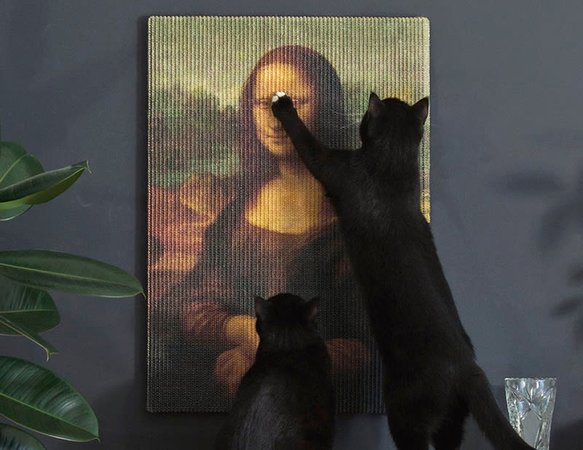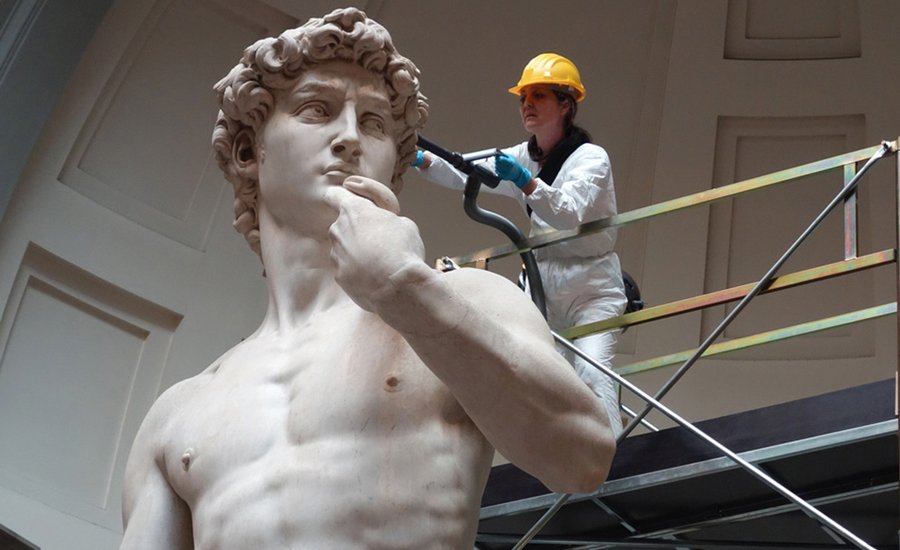Springtime is here, and with its abundance of pleasantries––warmer weather, longer days, flowers, and sunlight––comes a desire to cleanse ourselves of the dreadful winter slump. The old trope of “spring cleaning” exists for a reason: springtime is a great time to shed the excess (or mess) we’ve accumulated over the winter months, and finally open up a window or two.
So you’re vacuuming, dusting, and mopping. Everything is looking spic and span. But what about your art?
Something that is often overlooked when cleaning a home is one's collection of artworks. For many, once it’s on the wall, it stays on the wall. But art, like basically everything else, is subject to age over time (especially if you don’t live in a museum with a team of specialists tending to the works every day). It’s important to keep an eye out for small indications of wear and tear, whether it be due to climate or light exposure (or simply a need for a light dusting), and to stay on top of keeping your art in the best shape possible. Here are some tips to prevent your art from looking like this:
 Punched Claude Monet at the National Gallery of Ireland, Image courtesy of Huh.
Punched Claude Monet at the National Gallery of Ireland, Image courtesy of Huh.
1. DO AN ANNUAL CHECKUP.
Spring is a great time to check up on your artworks and make sure that they are still in tip top shape. It seems simple, but if you make a point to examine your artworks at least once a year, you can avoid any grave mishaps. "We've had clients whose work has actually fallen off the walls" Anne Rappa, a fine art insurance broker for Huntington T. Block tells me. "This is entirely preventable."
2. CHECK THE HANGING MECHANISMS.
To avoid having a work fall right off the wall, simply ensure that the hanging mechanisms of your works are still in tact. Hanging mechanisms can degrade over time, and may need to be replaced or adjusted. If there is any cause for concern, contact the person who installed the work (or, if you were unsatisfied, an alternative installation company) to restore the hardware. If you are installing a new piece in your home, Rappa suggests asking the installer to do a walk-through and check the hardware of your entire collection to make sure that it is up to date.
3. EXAMINE FOR ANY CRACKING OR VISIBLE SURFACE CHANGES.
Are there any noticable visible changes to the work since you installed it? Look for any surface degradation, cracking, or discoloration. Artworks, (paintings in particular) need to be kept in a suitable environment, as its structural elements are subject to expand and contract based on the surrounding humidity and temperature changes. As environmental conditions fluctuate, a painting may oscillate between becoming taut or loose, which can lead to cracking in the paint. If there's anything glaring, Rappa suggests calling in a professional restoration specialist. But if the change is minor, consider moving the artwork to a different location, as the placement of the work may be causing its wear.
4. EXAMINE THE ARTWORK'S REACTION TO ITS CURRENT ENVIRONMENT.
One of the most important factors in maintaining your collection is examining the placement of the works, particularly in relation to their exposure to elements such as light and heat. Artworks are like most people: they generally like to be in pleasant, neutral environments with relative humidity levels between 40-60%. You may have noticed how museums are always at a constant (often chilly) temperature. Museums have the means to maintain constant humidity levels and temperatures, because this is the ideal environment for an artwork. But unless you're one of those kids from E.L. Konisburg's classic From the Mixed-Up Files of Mrs. Basil E. Frankweiler, you probably don't live in a museum, and thus your works are likely exposed to at least slight seasonal changes. The name of the game is neutral. You're going to want to avoid any major fluctuations if possible. The American Institute for Conservation of Historic Artistic Works recommends attaching a Fome-core protective backing board to the stretcher bars of painted works to reduce the effects of rapid environmental changes (and also protect from dust and other foreign objects). In terms of temperature, avoid placing your works near a heater, air conditioner, fireplace, or shower. No matter how extreme or avant-garde the art is, it probably doesn't do well in these extreme environments.
To avoid discoloration, it's important to avoid direct sunlight, which can cause a varnish to yellow and, like all of the cereal boxes on display in the window at the local grocer, to fade considerably. If you do notice discoloration, move the artwork to a different location. According to the American Institute for Conservation of Historic Artistic Works, "indirect sunlight, recessed lighting, or ceiling-mounted spotlights are best for home installations."
5. INSTALL PROPER LIGHTING FIXTURES.
When lighting your collection, always use indirect lighting. Avoid a harsh glare and stay away heat-generating lightbulbs. Heat, as we know, is no friend to an artwork. Lights that attach to the top of a frame are usually a big no-no. As a resource for installating the proper lighting for your artworks, Rappa recommends Sandra Liotus Lighting Design LLC, who specialize in conservation lighting without using ultra violet or infra red elements.
6. DEVELOP RELATIONSHIPS WITH PROFESSIONALS YOU TRUST.
The American Institute for Conservation of Historic Artistic Works is a great resource for finding a professional who can tend to your specific needs. On their site , they lay out clear guidelines about how to find a professional conservator, and have developed a program to connect you with a conservator in your area. They also provide informational guides on how to care for specific historical heirlooms, artifacts, and artworks.
7. GET INTIMATE WITH YOUR ARTWORK, AND BE GENTLE!
Ultimately, all artworks are different. It is vital to know the medium of every piece in your collection, as various mediums respond differently to environmental elements. Do some research about the medium and hardware specific to your work and take the necessary precautions. Artworks also require specific cleaning methods, and when in doubt, it's usually better to contact a professional. If you are adamant about going DIY, always be extremely careful when cleaning your artworks. Commercial products can cause irreperable damage to an artwork. So put away the Windex! AICHAW recommends that you not use a feather duster, as these can scratch a work. They recommend using a soft bristle brush or a makeup brush, as these are less harmful.
---
In addition, here are some of our recommendations, for good measure (that are really more of an all-year-round, preventative care thing):
8. ENSURE THAT YOUR PETS DO NOT HAVE EASY ACCESS TO THE ART.
I don't know about your pets, but my cat's primary interest seems to be finding places he shouldn't be and scratching things I'd really rather he not scratch. I live with a painter, and our cat's favorite place to hang out is directly on top of any art object, and he loves to scratch any paintings within his reach. I looked this up and apparently this is not uncommon: there's even such a thing as a " Copycat Art Scratcher ," (developed by someone who had an embroidery artwork in his home destroyed by his pet), so your cats can feel like they're scratching a Mona Lisa without destroying an actual priceless Mona Lisa. (Though they are just shy of $200, which is a pretty steep price for a scratching post...unless you think of it as a form of insurance?) Otherwise, simply make sure to keep the artwork out of your pet's reach. Who knows what they do when they're home alone?
 Copycat Art Scratcher, Image courtesy of Studio Erik Stehmann
Copycat Art Scratcher, Image courtesy of Studio Erik Stehmann
9. FIND ALTERNATIVE OUTLETS FOR YOUR EMOTIONS.
Sometimes, when you're feeling really angry or sad, all you want to do is punch a hole in something. As satisfying as it might seem to punch a hole in a painting, I promise you that you will regret it once you are feeling a bit more at peace with the world. (Trust me, I've been there). But if you're still hankering for destruction, there's this handy little
website
that actually lets you virtually punch a Monet (the painting is "Argenteuil Basin with a Single Sailboat," the same one that was destroyed by a man at the National Gallery of Ireland in 2012). At the very least it should give you a bit of a laugh.
 Image courtesy of Punchamonet.gallery
Image courtesy of Punchamonet.gallery
10. ENCOURAGE FUN, NON-BALL THROWING INDOOR ACTIVITIES FOR YOUR KIDS, LIKE DRAWING OR READING.
You love your kids, and you love your art. But sometimes the two don't mix. Kids have a knack for rough-housing, it's just what they do. So first and foremost, just like your cats, make sure that your little ones have toys to play with so they're not suddenly tossing around a Kusama pumpkin sculpture. You might want to keep certain objects or pieces out of arm's reach, just in case. And it's probably a good idea to keep any indoor ball-tossing games to a minimum, as those just always end badly.
 Image courtesy of Servicewhale
Image courtesy of Servicewhale
Related Articles:
The Art of the Botch Job: What Happens When a Priceless Piece of Art is Destroyed?
Why & How: An Easy Guide to Starting an Art Collection
How to Buy an Artwork You'll Love on Artspace (or Anywhere Else, Really)
























